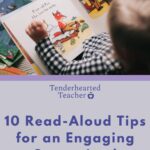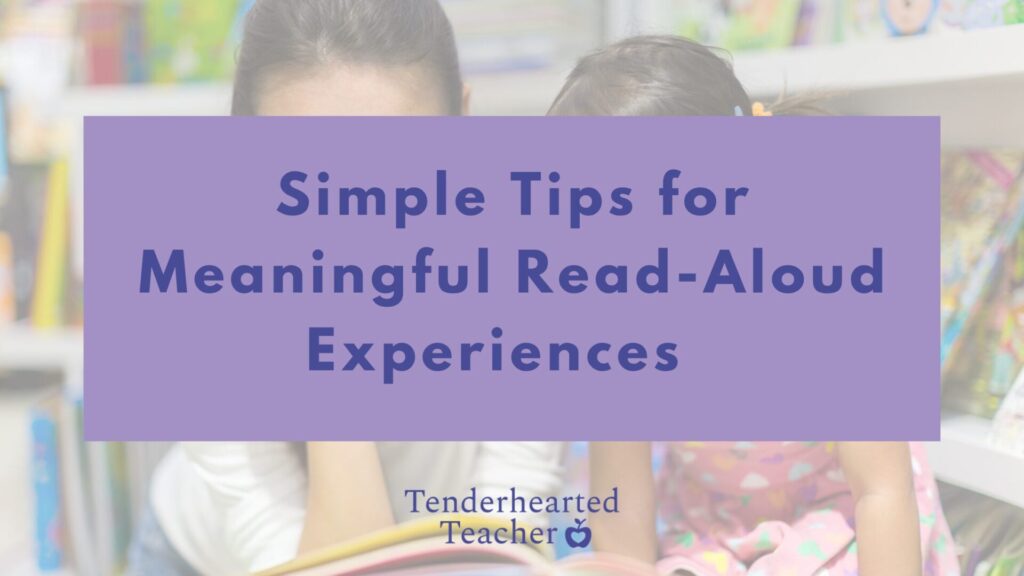
One of my absolute favorite things to do as a parent (and a teacher) is read with my kiddos! I love sharing new and exciting stories as well as rereading our favorites over and over again. Shared reading experiences are fantastic for numerous reasons. There’s even a yearly celebration that touts their amazing benefits! It’s called World Read-Aloud Day. It takes place this year on February 5th. So, I figured there’s no better time to share some of my go-to read-aloud tips for an engaging storytime. This post will dive into the benefits of reading with children as well as provide strategies for making your at-home storytime a success!
Please note: This post may contain affiliate links. As an Amazon Associate, I earn from qualifying purchases. Therefore, if you buy something through these links I will receive a small commission at no extra cost to you. Thank you for your support.
The Benefits of Shared Reading Experiences

There’s lots of talk online regarding parenting advice and child development, but many experts would agree that one of the most important things we can do for our children is to expose them to books! Shared reading experiences with our little ones can provide countless benefits and there are decades of research to back it up too! For example, a 1995 study found that read-alouds do wonders for literacy and language learning:
“Increasing evidence supports the view that shared reading encounters are not only enjoyable but also crucial for language and literacy development. Research has shown that adults who read regularly with young children tend to use more advanced vocabulary and syntactic structures during shared reading interactions than those who do not. Moreover, children who have experienced more shared reading sessions exhibit higher levels of emergent literacy skills, such as print knowledge, phonological awareness, and narrative comprehension.”
Bus, A. G., & Van Ijzendoorn, M. H. (1995)
Furthermore, several studies have noted the positive impact read-alouds have on social-emotional development. For instance, a 2012 study demonstrated a link between the parent and child discussions during shared reading–particularly those related to the book characters’ social-emotional dilemmas– and the child’s capacity for empathy. The authors stated, “The more that mothers converse about emotions and mental situations during joint reading, the more they will be able to add to their child’s knowledge about emotional experiences, and to cultivate the child’s emotional understanding and ability to express emotions.” (Aram D. & Shapira R., 2012. )
Therefore, you really can’t go wrong with a read-aloud. Let’s explore these potential benefits, and more, a bit further together. Read-alouds can:
Build Language & Literacy Skills
- A preschooler’s language and literacy development can significantly improve through regular read-aloud experiences. During the readings, they are exposed to a variety of words, print concepts, and sentence structures. This helps children expand their vocabulary, enhance phonological awareness and comprehension skills, and learn how we use our words to form sentences.
- Read-alouds also encourage back-and-forth engagement and provide opportunities for children to ask questions, make predictions, and express their ideas.
Foster a Love for Books and Strengthen the Child/Caregiver’s Bond
- Shared reading experiences promote positive bonds and create a sense of closeness and comfort for both the caregiver and the child. They also provide cherished memories.
- Exposing your child to captivating stories in a calm and safe setting can lay the groundwork for fostering a passion for reading at an early age.
Encourage Imagination, Creativity, and Problem-Solving Skills
- This one’s pretty obvious, but books are excellent tools for fostering creativity and imagination. Stories drop us into new worlds, take us on incredible adventures, and introduce us to unfamiliar places and characters.
- As previously mentioned, stories can promote empathy and compassion. But, they can also encourage critical thinking, problem-solving skills, and perseverance –especially when they feature characters overcoming challenges and obstacles through hard work and determination.
Promote Empathy, Compassion, and Emotional Awareness
- When a child is exposed to books with diverse characters, backgrounds, and perspectives they learn to appreciate differences and, in turn, become more compassionate and empathetic.
- Furthermore, books often address common childhood fears and anxieties. Therefore, read-alouds can help a child feel safe and secure especially when they are dealing with traumatic topics or times of stress or uncertainty, i.e. death of a loved one. Preschoolers learn healthy ways to cope with their emotions when they explore these themes safely with their caregivers.
Read-Aloud Tips For Meaningful Shared Reading Experiences
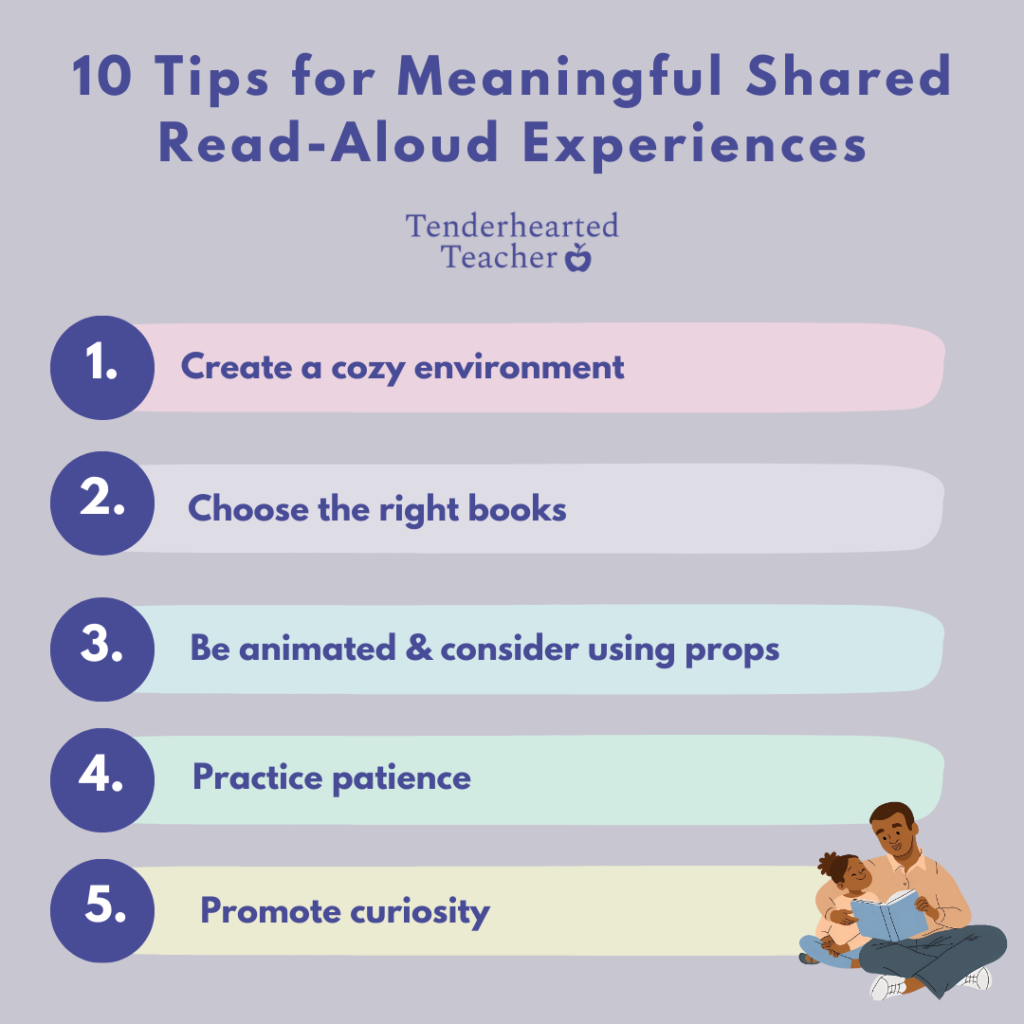
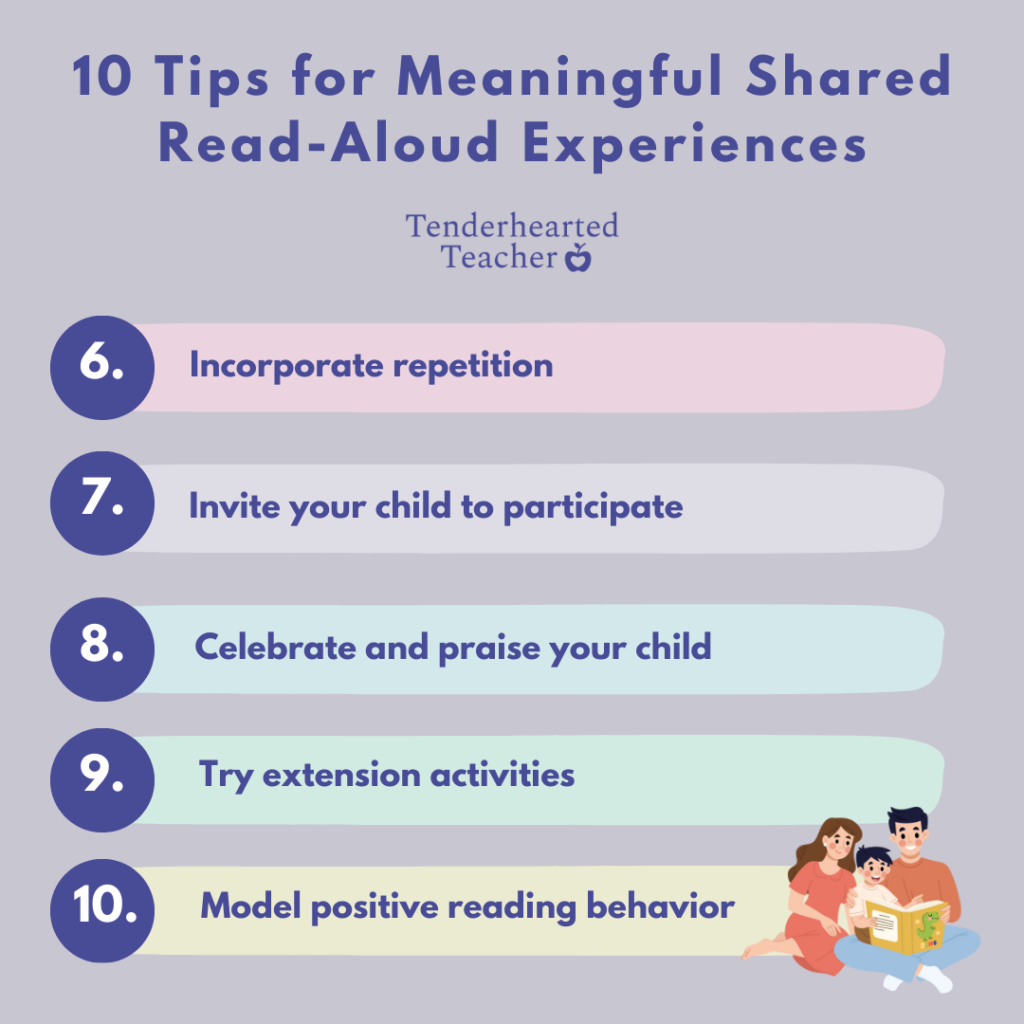
Now that we know just how incredible shared reading experiences are, it’s time to dive into some tips for successful read-alouds! Here are 10 of my favorite strategies for creating meaningful storytelling experiences with your preschooler:
1. Create a cozy environment
Provide your child with a quiet and comfortable reading area in your home. This could be on top of pillows on the floor of your child’s playroom, curled up on the couch, or atop your child’s bed. Make sure this spot allows your little one to easily see you and the book’s illustrations.
2. Choose the right books
There are lots of things to consider when selecting books. First, make sure they feature age-appropriate language, appealing illustrations, and relatable themes for preschoolers. For example, choosing books that align with your child’s interest, i.e. animals, vehicles, fairytales, etc, can make for a more enjoyable read. Second, make sure to include books with diverse characters and backgrounds. This allows your child to learn about experiences that are different than their own. Finally, incorporating various types of books such as fiction, nonfiction, and rhyming texts can allow your child to learn something new as well as enhance their existing knowledge.
3. Be animated and consider using props
Even if you don’t fancy yourself an actor, enthusiasm is key to a fun and engaging experience. Try using different voices for different characters to capture your preschooler’s attention. Additionally, you can enhance storytelling with props like dolls, puppets, or even flannel board characters.
4. Practice patience
An important thing to keep in mind is that preschoolers generally have short attention spans. Therefore, you may need to offer breaks during longer stories. If you notice your little one is getting antsy it’s okay to pause and adjust accordingly.
5. Promote curiosity
Ask story-related questions and expand on your child’s answers. For example, you can ask basic questions like “Who?” “What?” “When?” and “Where?” And higher-level questions such as “How would you solve this problem if this happened to you?” or “How do you think the character feels and why?” Also, allow time for your child to make predictions about the text.
6. Incorporate repetition
It’s completely normal for children to request the same book over and over again and it’s beneficial too! Repeated readings of your child’s favorite book can help reinforce language skills and improve comprehension.
7. Invite your child to participate
Encourage your little one to join in on the reading process with movement, gestures, and role-playing. For example, if the story features rhyming words or repetitive phrases, allow them to fill in the blanks during the reading. Or have your child retell the story to their sibling or stuffed animals.
8. Celebrate and praise your child
Acknowledge their input and provide positive reinforcement when they share their ideas about the story as well as when they make observations and predictions.
9. Try extension activities
Lots of children’s books have extension activities that are easily accessible online. So, after storytime is done you can continue the fun with additional activities. For instance, have your child retell the story with printed materials, toys, or their self-made drawings.
10. Model positive reading behavior
It’s critical to let your child see you reading for your enjoyment and pleasure (during your own quiet time, etc.) While shared reading is vital, it’s equally as important to set aside time for your child to read a variety of materials (books, comics, magazines) independently.
These 10 read-aloud tips can help set the foundation for a lifelong love of books as well as create positive and memorable shared experiences.
One of My Favorite Read-Aloud Authors
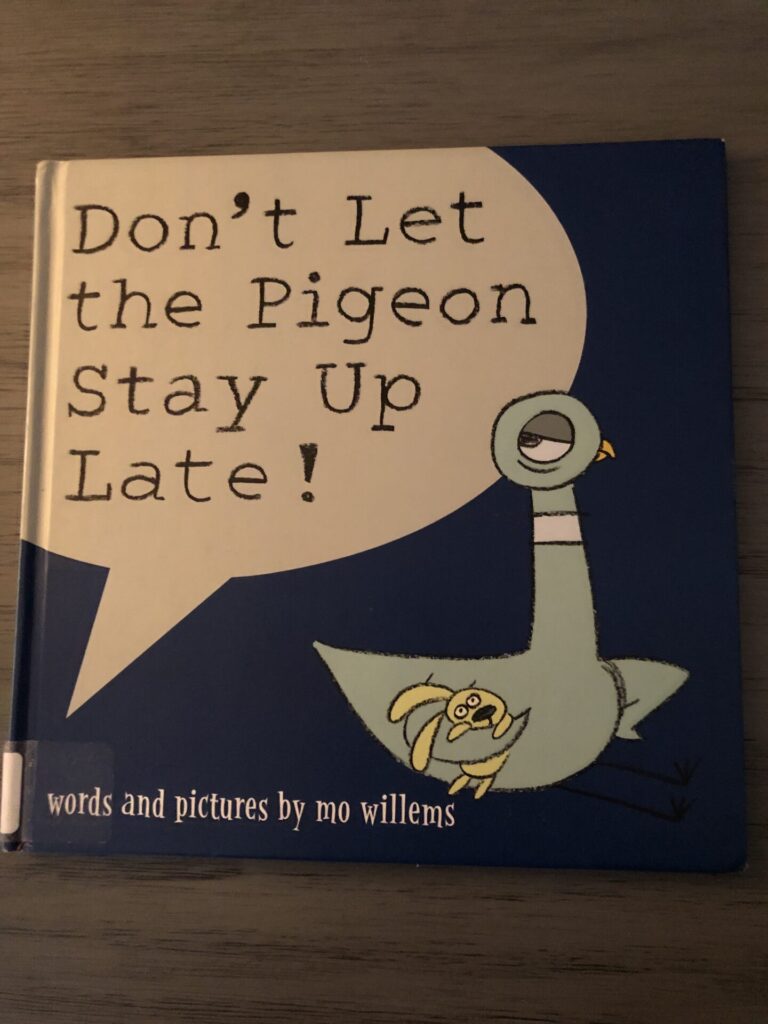
Right now in our house, we’re really into Mo Willems’ books! He’s got so many great ones including countless Pigeon books, the Elephant & Piggie series, and the three Knuffle Bunny books. (P.S. Have your tissues handy for Knuffle Bunny Free–this one always gets me teary-eyed!)
- Mo Willems (Author)
- English (Publication Language)
- 01/01/2009 (Publication Date) - Scholastic (Publisher)
- Hardcover Book
- Willems, Mo (Author)
- English (Publication Language)
- 1600 Pages - 09/04/2018 (Publication Date) - Hyperion Books for Children (Publisher)
- Mo Willems (Author)
- 136 Pages - 03/05/2024 (Publication Date) - Walker Book Ltd (Publisher)
Also, as many of you know I’m an aspiring picture book author. I am a part of Julie Hedlund’s 12 x 12 Picture Book Challenge. It’s a wonderful community in the KidLit world to hone your writing craft. They have an online bookstore featuring published 12×12 authors. You can check that out here for some fantastic books too!
Now talk to me! Do you have any additional read-aloud tips you’d like to add? Or perhaps you’d like to share your favorite books? If so, comment below!
Save to Pinterest
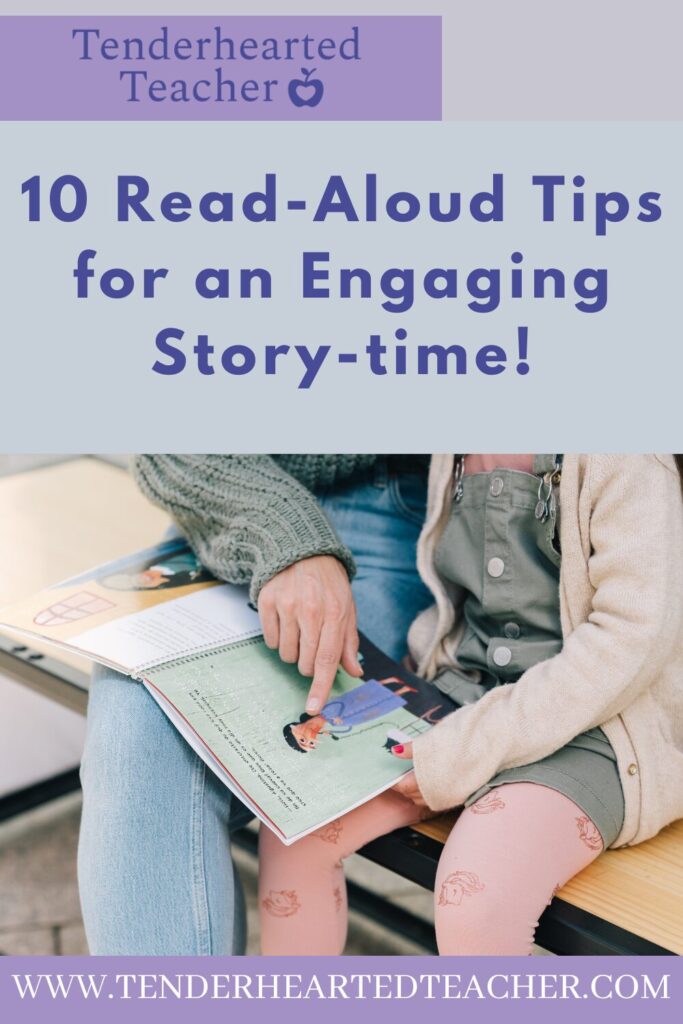
References: Aram D., Shapira R. (2012). Parent-child shared book reading and children’s language, literacy, and empathy development. Rivista. Italiana. di. Educazione. Familiare. 2, 55–65. doi: 10.1400/227336 Bus, A. G., & Van Ijzendoorn, M. H. (1995). Mothers Reading to Their 3-Year-Olds: The Role of Mother-Child Attachment Security in Becoming Literate. Reading Research Quarterly, 30(4), 998-1015.




